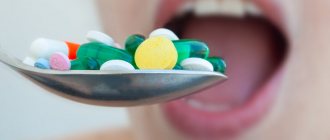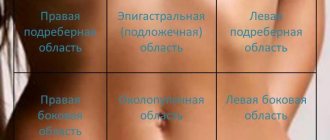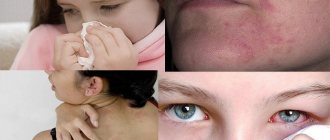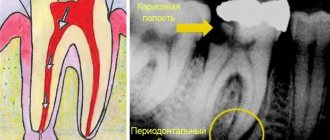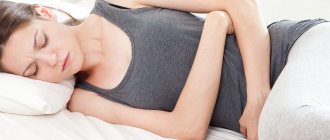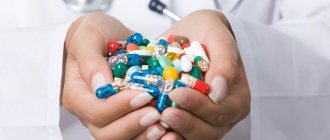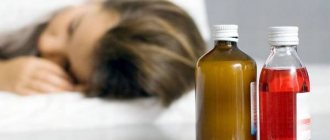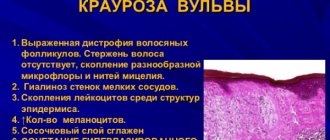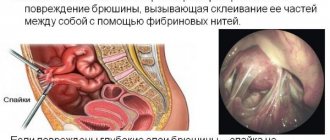What should be the first menstruation in girls and when does the first menstruation occur? Why does pain occur during menstruation? Read about the menstrual cycle and its meaning in our material.
Typically, by the time they reach puberty, most girls already have a basic understanding of menstruation. However, neither the Internet, nor girlfriends, nor popular women's magazines prepare a teenage girl for a new life event and the changes that are taking place.
It is the mother who has a huge responsibility: to support psychologically, explain everything in time and know what to do if “something goes wrong.”
What happens normally?
Under the influence of hormones during puberty, a girl undergoes amazing metamorphoses.
The first stage is before menarche.
In two to three years:
- Rapid physical development and weight gain.
- Hair growth in the armpits and pubic area.
- Enlargement and formation of mammary glands.
- Acne may appear on the skin of the face and/or body.
- The pelvic bones gradually expand.
In a few months:
- Rapid fatigue, dizziness and headaches, nausea.
- Vaginal discharge (leucorrhoea) increases due to changes in the vaginal microflora (lactobacteria appear).
- Sudden mood swings.
The second stage is the first menstruation or menarche.
It occurs around the age of 11-14 years, most often at 12-13 years. The average range is from 10 -11 to 14-15 years.
From the moment of menarche, a teenage girl can become pregnant even after a single sexual intercourse.
About early pregnancy
A regular menstrual cycle does not immediately “come into its own.” Within six months, the formation of an “adult” type of production and interaction of sex hormones with each other occurs. Previously, this process took 1-1.5 years - outdated data.
The menstrual cycle may lengthen or shorten by several days; in one month the discharge may be heavy, in another it may be scanty. The normal duration of the menstrual cycle is 25-35 days.
The third stage is the formation of a regular menstrual cycle
The normal duration is 3-5 days, less often - 7 days. The total volume of blood loss is 50-150 ml.
The development of the mammary glands and pelvis is completed, the body no longer grows so intensively in length.
Results
Doctors advise girls to be more sensitive, listen to their bodies, measure physical activity, and if they have heavy periods, generally refrain from doing so for a while. Observe what your menstruation is in terms of color, volume, smell. If there are no signs of acute inflammation in the body, then you can try to minimize attacks at home, take pain pills. The main thing is to prevent complications, since dysmenorrhea can be caused by a number of gynecological pathologies in the genital area.
If your critical days have become simply unbearable, then pain in the lower abdomen is most likely a signal of health problems and illness; only a doctor can make a diagnosis. It is important to understand that it is normal for teenage girls to experience only minor pain with the onset of menstruation. If other unpleasant signs are observed in combination: high temperature, itching and burning in the vagina, discharge of bloody discharge with a putrid, fetid odor, unusual color, then this clearly indicates an inflammatory course in the uterine cavity and you need to visit a gynecologist immediately.
80% of healthy women experience pain of varying intensity during menstruation. It is important to know that this is a normal physiological phenomenon. Drawing, aching pain in the lower abdomen lasts 2-3 days and goes away on its own. They are caused by active contraction of the uterus, which rejects the endometrium. Unbearable pain requires medical consultation.
Earlier or later menarche
If a mother or grandmother’s first menstruation occurred, for example, at the age of 15, then the girl’s maturation will most likely follow the same “scenario.”
However, most often the failure of the natural mechanism occurs due to diseases or characteristics of the girl’s body.
Before menarche - before 11 years of age
Functional causes: most often overweight or obesity. One of the estrogen (female sex hormones) is produced in adipose tissue, which leads to early puberty.
Diseases:
- Hypothyroidism is decreased production of thyroid hormones.
- Follicular ovarian cysts.
- Tumor of the ovary, adrenal gland, or central nervous system.
- Lesions of the central nervous system: meningitis, encephalitis, trauma and others.
Late menarche - over 14 years of age
Functional reasons:
- With malnutrition or excessive thinness due to lack of nutrients, the synthesis of sex hormones is disrupted. The body “extracts” estrogens from adipose tissue, but it is also not enough. A healthy girl should have at least 17% fatty tissue of her total body weight.
- Frequent stress and prolonged psycho-emotional stress lead to a failure in the formation of sex hormones.
- With intense exercise, estrogen production decreases.
Diseases:
- Insufficient production of sex hormones by the ovaries is most often associated with congenital underdevelopment of the ovaries.
- Diseases: diabetes mellitus, bronchial asthma (depending on the severity and controllability of the course).
- Congenital malformations of the reproductive system - for example, underdevelopment of the uterus or ovaries.
- Chromosomal or genetic diseases.
Doctors' opinion
- breathe more fresh air;
- fight nervousness, stress, fears;
- monitor your weight;
- eat right, food should be easily digestible;
- dose rest and sleep, sleep at least 8 hours;
- play sports without overloading the body;
- avoid bad habits (alcohol, smoking) that in one way or another can create serious preconditions for the failure of the functions of the genital reproductive organs.
Attention! If a diagnosis of “secondary dysmenorrhea” is made, then uncontrolled use of tranquilizers, analgesics, and strong painkillers during menstruation is prohibited for adolescents. For example, algomenorrhea is more often caused by organic disorders in the body systems: hormonal imbalance, dysfunction of the nervous system, impaired prostaglandin production. Prescription of medications is exclusively the responsibility of the attending physician.
With endometriosis, inflammation occurs in the genital organs. Negative symptoms often appear in combination. It is important to first identify the causes that provoked the disease and pain during menstruation. It is acceptable to take Acetaminophen, Paracetamol (1 tablet) to relieve inflammation and relieve pain. But uncontrolled, incorrect use of analgesics is fraught with a decrease in sensitivity to pain and the development of complications of the underlying disease.
Irregular menstrual cycle
The interval between menstrual bleeding lasts 1.5-2 months or more (delay).
- Polycystic ovary syndrome (PCOS) is the most common cause. Menarche occurs on time, but after a few months menstruation becomes rare (oligomenorrhea) or stops (amenorrhea). Possible uterine bleeding. Hair growth on the skin of the face and/or body may increase and follow a male pattern. Sometimes obesity develops.
- Increased production of male sex hormones in congenital dysfunction of the adrenal cortex. Early onset - girls from birth have external signs of boys, later - manifestations are similar to PCOS.
Painful periods
Much depends on individual pain tolerance, but there are certain criteria for differentiation.
What is considered normal?
Menstruation may be accompanied by discomfort, unexpressed heaviness and/or pain in the lower abdomen - part of the overgrown endometrium is rejected and the muscles of the uterus contract. General well-being is not affected, and critical days are easily tolerated.
When to sound the alarm?
The pain is severe, cramping or colicky, stabbing and cutting, sometimes painful and aching. They are located in the lower abdomen and/or in the sacrolumbar region, and can radiate to the groin. They begin a few hours before or on the day of menstruation, last one or two days, less often - longer. Nausea or vomiting, dizziness, and urination and bowel dysfunction may occur.
The reasons are not fully understood, but there are several factors:
- Hormonal imbalance between estrogen and progesterone against the background of emotional lability.
- Mechanical obstruction to outflow due to developmental anomalies: underdevelopment or bending of the uterus, narrowing of the internal pharynx (entrance to the uterus).
- Increased excitability of the nervous system leads to excessive contraction of the muscles of the uterus.
- Endometriosis. Foci of the uterine mucosa (endometrium) grow in atypical areas (normally they should not be there): ovaries, cervix, muscular layer of the uterus (adenomyosis). When menstruation occurs, the enlarged endometrium is rejected not only from the uterine cavity, but also from all foci - accompanied by severe pain and heavy menstrual bleeding.
Examination and solutions to problems
If there are no deviations from the norm, there is no need to consult a doctor - with the exception of preventive medical examinations according to age.
If problems arise, the main assistant is a pediatric obstetrician-gynecologist. Additionally, the girl is examined by doctors of other specialties - for example, an endocrinologist-gynecologist or a psychologist.
Scope of examinations
An ultrasound of the pelvic organs, thyroid gland and/or internal organs is performed, the level of hormones in the blood is determined, computed tomography and other studies are performed.
Unfortunately, the diagnostic capabilities of modern medicine are limited at this age:
- Diagnostic curettage of the uterine cavity is not performed.
- Laparoscopy is not recommended. With endometriosis, areas of the endometrium are often not visible on ultrasound. The diagnosis is confirmed only by laparoscopy - it is performed once simultaneously for diagnosis and treatment when planning pregnancy upon reaching childbearing age.
If absolutely necessary, some studies are performed with the consent of the parents and by decision of the medical commission.
Solutions
Functional changes: usually it is enough to normalize weight, diet and rest, and optimize physical activity.
The task is quite difficult if the problem is not identified or the cause cannot be eliminated (developmental anomalies).
Doctors often have to act at random:
- To reduce pain, antispasmodics (relax muscles), painkillers and non-steroidal anti-inflammatory drugs (NSAIDs - reduce pain and swelling) are used.
- For heavy menstruation and a tendency to bleeding - tranexamic acid, NSAIDs and others.
Prescribing effective treatment largely depends on the doctor’s experience and his approach to solving problems using the achievements of modern medicine.
Hormonal preparations containing drospirenone and dienogest have been developed Some of them are approved for use in adolescent girls with PCOS, suspected endometriosis, dysfunctional uterine bleeding, juvenile acne and other conditions.
Taking hormones also has a positive effect in cases of severe pain - when nothing else helps.
Cases of successful use of these drugs for a long time, up to childbearing age, with subsequent withdrawal and the onset of pregnancy, have been described.
Hormones are prescribed with the consent of the parents and by decision of the medical commission.
Pain Treatment Methods
The first goal of therapy is to eliminate the cause that causes such severe pain. Most often, an integrated approach is used, which consists of taking medications:
- Oral contraceptives and combined hormones - they regulate hormonal levels, reduce estrogen and prostaglandin levels, and can affect pain without additional drugs.
- NSAIDs based on ibuprofen or indomethacin are powerful painkillers that can only be taken as prescribed by a doctor in limited quantities.
- No-spa and other antispasmodics are more effective if the symptoms are associated with disturbances in muscle function and uterine spasms;
- Be sure to take vitamins - they replenish the level of magnesium and calcium, with sufficient levels of which menstruation is not so painful.
- If the psychotherapist advises, take light tranquilizers.
- reflexology;
- UHF treatment;
- electronography;
- balneotherapy.
These techniques help fight inflammation, normalize blood circulation, stimulate reproductive functions and restore the menstrual cycle. But they cannot be used for endometriosis and asthenic syndrome.
Treatment with folk remedies
With the help of traditional medicine, you can get rid of obsessive abdominal pain during menstruation without pills, but doctors urge parents not to forget that natural remedies act more slowly and require long-term use. Herbal therapy is carried out in courses; in 3-6 months the pain can be significantly reduced.
- A mixture of horsetail, cinquefoil, knotweed, yarrow and centaury. Prepare a decoction of 1 tbsp. l. collection infused in 1 glass of boiling water. Take 3 times a day, 2 tbsp. l. before meals for 3-4 weeks.
- Calendula infusion. Brew 3 tbsp. l. in 500 ml of boiling water and infuse. Used for douching 3 times a day for 5 days in a row.
- Melissa. The decoction is used to combat nervousness, brew 2 tbsp. l. in 1 glass of boiling water and infuse. After 3 hours, take 100 ml 3 times a day.
- Celery infusion. Take 2-3 tbsp. l. plant seeds and brew with boiling water for 8 hours. Take 1 spoon 4 times a day before meals.
Any prescription is first discussed with the doctor. It is prohibited to take natural herbs without consultation, even if they were recommended by friends.
Massage and exercise
Treatment cannot be done without moderate physical activity:
- yoga restores oxygen supply;
- massage helps relax organs;
- physical education strengthens the anterior abdominal wall;
- Acupuncture helps relieve pain and normalize tissue nutrition.
